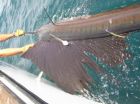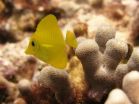(Press-News.org) Billfish and tuna, important commercial and recreational fish species, may be more vulnerable to fishing pressure because of shrinking habitat, according to a new study published by scientists from NOAA, The Billfish Foundation, and University of Miami Rosenstiel School of Marine and Atmospheric Science.
An expanding zone of low oxygen, known as a hypoxic zone, in the Atlantic Ocean is encroaching upon these species' preferred oxygen-abundant habitat, forcing them into shallower waters where they are more likely to be caught.
During the study, published recently in the journal Fisheries Oceanography, scientists tagged 79 sailfish and blue marlin with satellite tracking devices in the western North Atlantic, off south Florida and the Caribbean; and eastern tropical Atlantic, off the coast of West Africa. The pop off archival satellite tags monitored horizontal and vertical movement patterns. Researchers confirmed that billfish prefer oxygen rich waters closer to the surface and will actively avoid waters low in oxygen.
While these hypoxic zones occur naturally in many areas of the world's tropical and equatorial oceans, scientists are concerned because these zones are expanding and occurring closer to the sea surface, and are expected to continue to grow as sea temperatures rise.
"The hypoxic zone off West Africa, which covers virtually all the equatorial waters in the Atlantic Ocean, is roughly the size of the continental United States, and it's growing," said Dr. Eric D. Prince, NOAA's Fisheries Service research fishery biologist. "With the current cycle of climate change and accelerated global warming, we expect the size of this zone to increase, further reducing the available habitat for these fish."
Less available habitat can lead to more fish being caught since the fish are concentrated near the surface. Higher catch rates from these areas may give the false appearance of more abundant fish stocks. The shrinking availability of habitat and resulting increases to catch rates are important factors for scientists to consider when doing population assessments.
Researchers forecast that climate change and its associated rise in ocean temperatures will further increase the expansion of hypoxic zones in the world's oceans. As water temperature increases, the amount of oxygen dissolved in water decreases, further squeezing billfish into dwindling available habitat and exposing them to even higher levels of exploitation.
INFORMATION:
NOAA's mission is to understand and predict changes in the Earth's environment, from the depths of the ocean to the surface of the sun, and to conserve and manage our coastal and marine resources. Visit us at http://www.noaa.gov or on Facebook at http://www.facebook.com/usnoaagov.
On the Web:
NOAA Fisheries Service Southeast Region:
http://sero.nmfs.noaa.gov
Atlantic Highly Migratory Species:
http://www.nmfs.noaa.gov/sfa/hms/hmsdocument_files/BILLFISH.htm
Fisheries Oceanography article:
http://onlinelibrary.wiley.com/doi/10.1111/j.1365-2419.2010.00556.x/pdf
Growing hypoxic zones reduce habitat for billfish and tuna
Less habitat could increase vulnerability to fishing, affect population assessments
2010-12-23
ELSE PRESS RELEASES FROM THIS DATE:
Ever-sharp urchin teeth may yield tools that never need honing
2010-12-23
MADISON – To survive in a tumultuous environment, sea urchins literally eat through stone, using their teeth to carve out nooks where the spiny creatures hide from predators and protect themselves from the crashing surf on the rocky shores and tide pools where they live.
The rock-boring behavior is astonishing, scientists agree, but what is truly remarkable is that, despite constant grinding and scraping on stone, urchin teeth never, ever get dull. The secret of their ever-sharp qualities has puzzled scientists for decades, but now a new report by scientists from the ...
Study shows drifting fish larvae allow marine reserves to rebuild fisheries
2010-12-23
CORVALLIS, Ore. – Marine ecologists at Oregon State University have shown for the first time that tiny fish larvae can drift with ocean currents and "re-seed" fish stocks significant distances away – more than 100 miles in a new study from Hawaii.
The findings add credibility to what scientists have believed for some time, but until now been unable to directly document. The study also provides a significant demonstration of the ability of marine reserves to rebuild fishery stocks in areas outside the reserves.
The research was published this week in PLoS One, a scientific ...
University of Minnesota discovery suggests a new way to prevent HIV from infecting human cells
2010-12-23
Researchers at the University of Minnesota have discovered how HIV binds to and destroys a specific human antiviral protein called APOBEC3F. The results suggest that a simple chemical change can convert APOBEC3F to a more effective antiviral agent and that shielding of a common feature shared by related proteins may yield a similar outcome.
This discovery highlights the potential for a novel approach to combating HIV/AIDS that would seek to stabilize and harness the innate antiviral activity of certain human proteins, according to lead author John Albin, a researcher ...
Pterygotid sea scorpions: No longer terror of the ancient seas?
2010-12-23
BUFFALO, NY (December 22, 2010) -- Experiments by a team of researchers in New York and New Jersey have generated evidence that questions the common belief that the pterygotid eurypterids ("sea scorpions") were high-level predators in the Paleozoic oceans. This group, which ranged the seas from about 470 to 370 million years ago (long before the dinosaurs appeared), included the largest and, arguably, scariest-looking arthropods known to have evolved on planet Earth. Reaching lengths of 2 ½ meters with a body supported by well-developed legs, and armed with a pair of forward-facing ...
Mount Sinai researchers make major breakthrough in melanoma research
2010-12-23
In a breakthrough that could lead to new treatments for patients with malignant melanoma, researchers from Mount Sinai School of Medicine have discovered that a particular protein suppresses the progression of melanoma through regulation of an oncogene, or gene responsible for cancer growth. The study is published in the December 23 issue of Nature.
Researchers studied the natural progression of melanoma using mouse and human cells, as well as patient samples and determined that the presence of a specific histone variant, which is a protein that helps package DNA, was ...
Why does dialysis fail?
2010-12-23
A protein implicated in the development of vascular diseases may also contribute to the failure of arteriovenous (AV) fistulas created for vascular access in dialysis patients, according to a study appearing in an upcoming issue of the Journal of the American Society of Nephrology (JASN).
"Our findings raise the possibility that monocyte chemoattractant protein-1 (MCP-1) may contribute to the relatively poor outcomes regarding the function and longevity of human hemodialysis AV fistulas," comments Karl A. Nath, MB.ChB (Mayo Clinic, Rochester, MN).
AV fistulas are the ...
America's stroke belt partially fueled by fried fish
2010-12-23
BIRMINGHAM, Ala. – Eating a Southern staple, fried fish, could be one reason people in Alabama and across the "stroke belt" states are more likely than other Americans to die of a stroke, according to a study published in the December 22, 2010, online issue of Neurology, the medical journal of the American Academy of Neurology (AAN).
In the stroke belt states – Alabama, Arkansas, Georgia, Louisiana, Mississippi, North Carolina, South Carolina and Tennessee – the risk of dying from stroke is higher than in other parts of the country. In Alabama, the stroke death rate ...
High red blood cell folate levels linked to silenced tumor-suppressors
2010-12-23
HOUSTON — People with higher levels of folate in their red blood cells were more likely to have two tumor-suppressing genes shut down by methylation, a chemical off switch for genes, researchers report in the December issue of Cancer Prevention Research.
DNA hypermethylation, notes co-author Jean-Pierre Issa, M.D., professor in MD Anderson's Department of Leukemia, is found in a variety of cancers and diseases of aging, such as heart disease. Methyl groups attach to genes at sites called CpG islands and protrude like tags or book marks from the promoter region, preventing ...
Fat cells become useful stem cells in tissue reconstruction
2010-12-23
Tampa, Fla. (Dec. 23, 2010) – Two studies appearing in the current issue
of Cell Transplantation 19(10) discuss stem cells derived from adipose (fat) cells and their potential use in plastic surgery and tissue reconstruction. The studies are now freely available on-line at http://www.ingentaconnect.com/content/cog/ct/ .
Adipose-derived stem cells maintain their "stemness" and could be useful for cell-based therapies
A team of researchers from several institutions in Italy isolated and characterized adult fat cell-derived stem cells from patients undergoing lipoaspiration ...
Ben-Gurion U researcher reveals newspapers' historic resistance to granting reporters' bylines
2010-12-23
NEW YORK, December 23, 2010 – A new study by Dr. Zvi Reich, a researcher at Ben-Gurion University of the Negev (BGU) in Beer-Sheva, Israel, documents the process through which journalists at major newspapers fought to receive byline recognition of their work, paving the way for today's celebrity journalists.
According to the study published in the December 2010 issue of Journalism, an academic journal, "the proliferation of bylines characterized the news as an imperfect, all too human account of reality, and opened the way for celebrity journalism."
Dr. Zvi Reich explains ...
LAST 30 PRESS RELEASES:
The Ceramic Society of Japan’s Oxoate Ceramics Research Association launches new international book project
Heart-brain connection: international study reveals the role of the vagus nerve in keeping the heart young
Researchers identify Rb1 as a predictive biomarker for a new therapeutic strategy in some breast cancers
Survey reveals ethical gaps slowing AI adoption in pediatric surgery
Stimulant ADHD medications work differently than thought
AI overestimates how smart people are, according to HSE economists
HSE researchers create genome-wide map of quadruplexes
Scientists boost cell "powerhouses" to burn more calories
Automatic label checking: The missing step in making reliable medical AI
Low daily alcohol intake linked to 50% heightened mouth cancer risk in India
American Meteorological Society announces Rick Spinrad as 2026 President-Elect
Biomass-based carbon capture spotlighted in newly released global climate webinar recording
Illuminating invisible nano pollutants: advanced bioimaging tracks the full journey of emerging nanoscale contaminants in living systems
How does age affect recovery from spinal cord injury?
Novel AI tool offers prognosis for patients with head and neck cancer
Fathers’ microplastic exposure tied to their children’s metabolic problems
Research validates laboratory model for studying high-grade serous ovarian cancer
SIR 2026 delivers transformative breakthroughs in minimally invasive medicine to improve patient care
Stem Cell Reports most downloaded papers of 2025 highlight the breadth and impact of stem cell research
Oxford-led study estimates NHS spends around 3% of its primary and secondary care budget on the health impacts of heat and cold in England
A researcher’s long quest leads to a smart composite breakthrough
Urban wild bees act as “microbial sensors” of city health.
New study finds where you live affects recovery after a hip fracture
Forecasting the impact of fully automated vehicle adoption on US road traffic injuries
Alcohol-related hospitalizations from 2016 to 2022
Semaglutide and hospitalizations in patients with obesity and established cardiovascular disease
Researchers ‘listen in’ to embryo-mother interactions during implantation using a culture system replicating the womb lining
How changing your diet could help save the world
How to make AI truly scalable and reliable for real-time traffic assignment?
Beyond fragmented markets: A new framework for efficient and stable ride-pooling
[Press-News.org] Growing hypoxic zones reduce habitat for billfish and tunaLess habitat could increase vulnerability to fishing, affect population assessments

